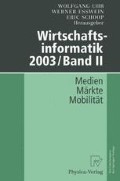Zusammenfassung
Spam hat sich in den letzten Jahren von einem „Ärgernis“ zu einem wirtschaftlich bedeutenden Problem entwickelt. In diesem Beitrag werde ich aufzeigen, daβ zur Erforschung der Probleme, die durch Spam verursacht werden, und der Maβnahmen, die gegen Spam ergriffen werden können, eine interdisziplinäre „Brille“ notwendig ist, da neben eher technischen Aspekten auch wirtschaftliche und juristische Aspekte berücksichtigt werden müssen. Damit ist die Wirtschaftsinformatik als Forschungsrichtung prädestiniert für den Aufbau eines umfassenden und vielschichtigen Verständnisses des Spam-Phänomens und seiner technischen, unternehmerischen und nicht zuletzt auch gesellschaftlichen Auswirkungen.
Access this chapter
Tax calculation will be finalised at checkout
Purchases are for personal use only
Preview
Unable to display preview. Download preview PDF.
Literatur
Aberdeen Group 2002: 2003: Predictions for Security and Privacy. Artikel verfügbar unter URL http://www.aberdeen.com/ab%5Fcompany/researchareas/ security2003.htm, Abruf am 2003-01-13.
Baseley, W. D.: The Email Abuse FAQ (last updated June 25, 1998) Artikel verfügbar unter URL http://members.aol.com/emailfaq/emailfaq.html, Abruf am 2003-01-13, oder in den Usenet newsgroups news.admin.net-abuse.email, news.answers.
Press Release: Brightmail Reveals Annual Top 10 Spam Messages for 2002. Artikel verfügbar unter URL http://www.brightmail.com/pressreleases/ 121202_top_spam.html, Abruf am 2003-01-10.
Castells, M.: The Internet galaxy. Reflections on the Internet, Business and Society. Oxford University Press, Oxford, UK.
Coalition Against Unsolicited Commercial Email (CAUCE). The Problem. Artikel verfügbar unter URL http://www.cauce.org/about/problem.shtml, Abruf am 2003-01-10.
SpamNet http://www.cloudmark.com/products/spamnet/, Abruf am 2003-01-10.
Cranor, L.F., LaMacchia, B.A. Spam! Communications of the ACM Volume 41, No 8, S. 74–83.
Donnerhacke, L. Teergruben FAQ. Artikel verfügbar unter URL http://www.iks-jena.de/mitarb/lutz/usenet/teergrube.html, Abruf am 2003-01-10.
Dwork, C., Naor, K.: Pricing via processing: combatting junk mail. Advances in Cryptology — 1992. Lecture Notes in Computer Science 740, Springer-Verlag, S. 139-147.
Fahlman, S. E.: Selling interrupt rights: a way to control unwanted e-mail and telephone calls. IBM Systems Journal Vol 41, No 4, 2002, S. 759–766.
Falk, J.D.: The Net Abuse FAQ. Artikel verfügbar unter URL http://www.cybernothing.org/faqs/net-abuse-faq.html, Abruf am 2003-01-13.
U.S. Federal Trade Commission: False claims in spam. A report by the FTC’s division of marketing practices. Released April 30, 2003. Available at http://www.ftc.gov/reports/spam/030429spamreport.pdf, Abruf am 2003-03-05.
Hall, R. Channels: avoiding unwanted electronic mail. Communications of the ACM Volume 41,N03.
Heidrich, J.: Gesetzes-Novelle mit Schwachstellen beim Spam-Schutz. c’t aktuell — Meldung vom 08.05.2003. Artikel verfügbar unter URL http://www.heise.de/ct/aktuell/data/jo-08.05.03-000/, Abruf am 2003-05-12.
Heise Online News vom 04.01.2003: Spam belastet Europas Unternehmen. Artikel verfügbar unter URL http://www.heise.de/newsticker/data/ae-04.01.03-003/, Abruf am 2003-01-13.
Heise Online News vom 09.02.2003: Spam-Filter verärgert britische Abgeordnete. Artikel verfügbar unter URL http://www.heise.de/newsticker/data/wst-09.02.03-003/, Abruf am 2003-02-09.
Jesdanun, A.: Study Says Spam Costs U.S. Businesses $8.9 Billion. Information Week Jan. 3, 2003. Artikel verfügbar unter URL http://www.information week.com/story/IWK20030103S0004, Abruf am 2003-01-10.
Lichtenstein, S. und Swatman, P.: Issues in e-business security management and policy. In Proceedings of the 1st Australian Information Security Management Workshop, 2000.
Lueg, C.: A look at wider impacts of spam and anti-spam measures. Zur Veröffentlichung einreicht.
Mueller, S. H.: What is Spam? http://spam.abuse.net/overview/whatis spam.shtml, Abruf am 2003-01-13.
Spam Conference http://spamconference.org/, Abruf am 2003-01-13.
Australian National Office for the Information Economy: Final report of the NOIE review of the spam problem and how it can be countered. Report available at http://www.noie.gov.au/projects/confidence/Improving/Spam/Interim_Report/contents. htm, Abruf am 2003-05-03.
Stone, B. and Lin, J: Spamming the World. Newsweek August 19, S. 40-42. [SSH03] SpamStopsHere http://www.spamstopshere.com/, Abruf am 2003-05-03.
The Spamhaus Project: Spammers Grab Hotmail and MSN addresses. Artikel verfügbar unter URL http://www.spamhaus.org/newsdog.lasso?article=114, Abruf am 2003-01-13.
The Spamhaus Project. The Spamhaus Block List (SBL) Advisory Frequently Asked Questions. Artikel verfügbar unter URL http://www.spamhaus.org/sbl/sbl-faqs.lasso, Abruf am 2003-01-13.
Wendlandt, B.: Cybersquatting, Metatags und Spam. Beck Juristischer Verlag. ISBN 3406489176.
Author information
Authors and Affiliations
Editor information
Editors and Affiliations
Rights and permissions
Copyright information
© 2003 Springer-Verlag Berlin Heidelberg
About this paper
Cite this paper
Lueg, C.P. (2003). „Sie haben schon wieder Post“: Spam als Forschungsgebiet der Wirtschaftsinformatik. In: Uhr, W., Esswein, W., Schoop, E. (eds) Wirtschaftsinformatik 2003/Band II. Physica, Heidelberg. https://doi.org/10.1007/978-3-642-57445-0_3
Download citation
DOI: https://doi.org/10.1007/978-3-642-57445-0_3
Publisher Name: Physica, Heidelberg
Print ISBN: 978-3-642-63267-9
Online ISBN: 978-3-642-57445-0
eBook Packages: Springer Book Archive

